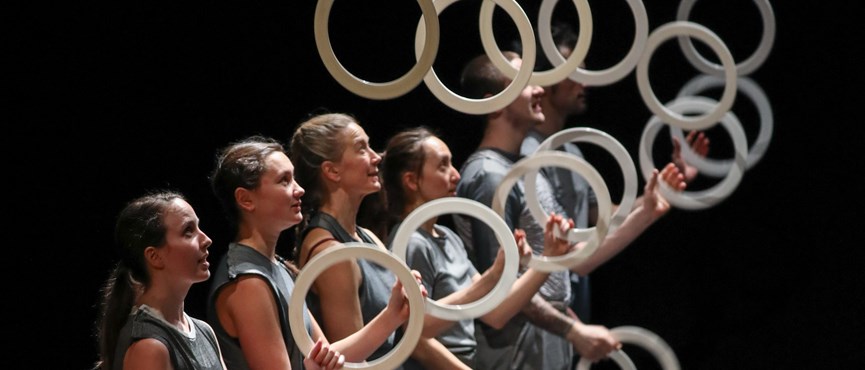After 29 years of experimenting at the boundaries of juggling, Gandini Juggling have returned to their earliest roots, merging contemporary dance with juggling in their latest work, Spring. Choreographed by Alexander Whitley (a New Wave associate artist at Sadler’s Wells, who previously worked with Ballet Rambert and Michael Clark, before forming his own contemporary dance company), and featuring dancers from Whitley’s company alongside performers from Gandini Juggling, this is a beautifully complex and driving work charting new territory, whilst also squeezing in recognisable Gandini motifs.
It was in the early 1990s that Gandini Juggling began combining contemporary dance with juggling. Inspired by classes with the late Gill Clarke they invited her to choreograph what was to become nEither Either botH and. This was a gentle and meticulous deconstruction of juggling, pulling it apart to find the dance inside. By contrast, in Spring, Whitley seeks to find a way to genuinely hybridise dance and juggling, particularly in the exploration of low centres of gravity and the dominance of floor work. What Clarke and Whitley share, though, is the desire to choreograph new (juggling) material – not to relocate established patterns and motifs into the choreographic world, but to genuinely find new patterns and new forms of dance-juggling. And so, Spring (alongside Sigma, their collaboration with Bharatanatyam choreographer Seeta Patel, before it) finds a place as one of Gandini Juggling’s most groundbreaking works.
At the heart of Spring is also the choreography’s relationship to music and to light. The score by Gabriel Prokofiev – which fuses live drumming, a string ensemble (Camerata Alma Viva), and electronic music) – is the driving force of the piece, catapulting the performers and objects through the space. It is both relentless and enticing, so much so that the moments of silence land as clear punctuations in the work. It is in these moments of silence that Gandini’s humanisation of the performer allows space to breathe; with one or more performers facing the audience to introduce each other in silence. These moments, familiar from other Gandini works, provide a moment of rest, a kind of luftpause, for the audience.
There are also moments of respite in Guy Hoare’s lighting score, which is guided by a similar depth and intensity. His palette plays deep shades of colour off against starker paler states, shifting the mood in striking ways throughout the dance. Hoare also plays with the visibility and invisibility of the musicians (sat upstage and often in striking poses when not playing), hiding and revealing them in different manners throughout the work. In doing so, Hoare shifts the music from hidden, ethereal accompaniment to a live and present force.
Amongst this world of sound and light, the juggling and dancing blur. Though experts will pick out the specialists, it becomes increasingly clear that everyone is dancing and everyone is juggling. The choreography is nuanced and rapid, with dance-juggling moves that shift across the floor and into space. One, two, three balls move between the dancer-jugglers: the balls arch through the air, or are placed into hands. Arms and legs move sinuously, weaving in and out of each other, just as the balls do. Even in the more complex scores there is a space for everyone. The established company members of Gandini Juggling, Kati Ylâ-Hokkala, Kim Huyn and Erin O’Toole, bring a rootedness to the performance, around which the younger and newer members of this collaboration orbit and weave.
Gandini Juggling have often welcomed guest performers to their works, and this performance at Sadler’s Wells was another of these occasions, with award-winning, world-record-holding American juggler Wes Peden bringing a virtuoso display of juggling skill to proceedings. Peden is a slightly rough and ready contrast to Whitley’s slick choreography, but this is his function; another shift in rhythm and tone that enhances the richness of the overall work. Gandini Juggling have a fondness for placing anarchic figures into their work, and here Peden is just that figure.
Although much of Spring is almost an entirely new territory for Gandini Juggling, there are still trademark Gandini structures, once again reinvented: the counting of counts, the naming of colours, the gentle recognition of drops, the prone line of jugglers juggling above their chests – and of particular note, four-person ring-passing patterns.
The last of these is a long-established part of Gandini’s work, appearing in various forms since the 1990s, but most often seen as a single-file line of four jugglers, each facing into the centre of the line and passing to the other three jugglers. It is a captivating arrangement, that combines a mathematical rigour with an elegant flow. In Spring, it is transformed by the addition of an old established juggling trick of ‘changing’ each ring’s colour whilst being juggled, so that a red ring becomes a blue ring, a white becomes a yellow, or other dizzying combinations. In doing so, each pattern’s structure might be revealed so that we can see the ‘code’, or it might become ever more complex so that we are disorientated.
In this fusion, Spring is a total theatre, where the artforms of dance, juggling, light design, and music weave and bob their way in and out of each other, rarely settling in one place for long. It is a cavalcade that is satisfyingly exhausting to watch, and like all good works you have the feeling that a second (and a third) viewing would allow you to fathom the depths of it just a little more. The question I often return to is: Where next for Gandini Juggling? What surprises might they have in store?

